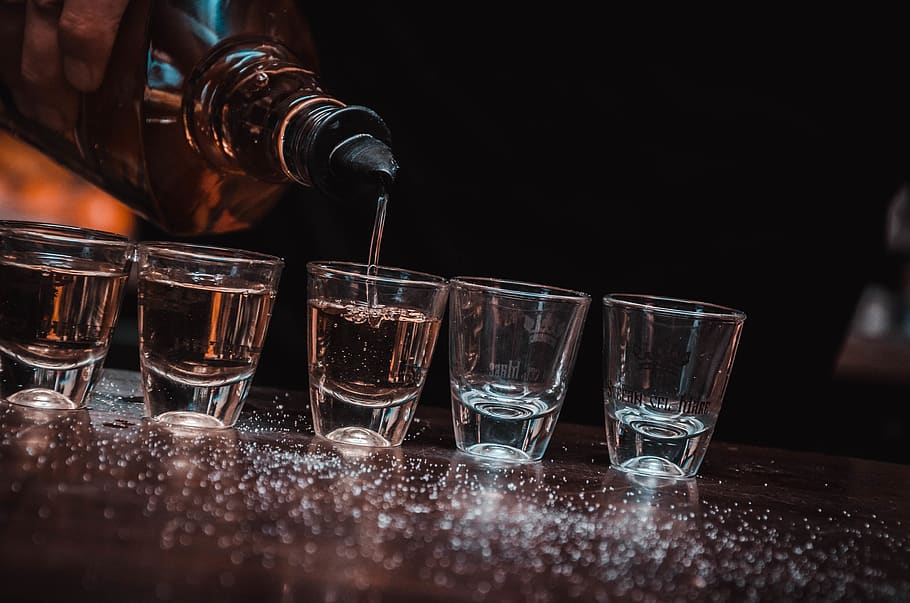
Whiskey is a popular alcoholic beverage that many people enjoy. However, how much whiskey does it take to get drunk? The answer to this question can vary depending on several factors, such as a person’s weight, gender, tolerance, and the amount of food they have consumed.
Table of Contents
Understanding Alcohol Content in Whiskey
In this section, we will discuss the alcohol content of whiskey and how it can affect your body.
Alcohol By Volume (ABV)
Alcohol by Volume (ABV) is the standard measure of the alcohol content in a beverage. ABV of whiskey can vary depending on the type of whiskey and the brand. Generally, whiskey has an ABV between 40% to 50%.
It is important to note that the higher the ABV, the more alcohol is present in the beverage. This means that a smaller amount of high ABV whiskey can have the same effect as a larger amount of low ABV whiskey. Therefore, it is important to be aware of the ABV of the whiskey you are consuming.
Standard Drink Size
A standard drink size is a measure that can help you keep track of how much alcohol you are consuming. In the United States, a standard drink size is defined as 14 grams (0.6 ounces) of pure alcohol. This can generally be found in:
- 12 ounces of beer, or one bottle at 5% ABV
- 8 ounces of malt liquor at 7% ABV
- 5 ounces of wine at 12% ABV
- 5 ounces of distilled spirits, such as whiskey, at 40% ABV
It is important to keep in mind that these are only guidelines, and the actual alcohol content of a beverage may vary. Additionally, the effects of alcohol can vary depending on factors such as body weight, gender, and tolerance.
Effects of Alcohol on the Body
Alcohol can have a range of effects on the body, depending on the amount consumed and the individual’s tolerance. In small amounts, alcohol can have a relaxing effect and can lower inhibitions. However, in larger amounts, alcohol can impair judgment, coordination, and reaction time.
Consuming too much alcohol can also lead to more serious health problems, such as liver damage, high blood pressure, and increased risk of certain cancers. It is important to consume alcohol in moderation and to be aware of the alcohol content of the beverages you are consuming.
Factors Influencing Intoxication
Several factors can influence how quickly a person becomes intoxicated after drinking whiskey. These factors include:
- Body weight and size: Generally, the larger and heavier a person is, the more alcohol they can consume before feeling the effects of intoxication.
- Gender: Women tend to have a lower tolerance for alcohol than men due to differences in body composition and metabolism.
- Age: As people age, their bodies become less efficient at metabolizing alcohol, which can lead to a higher blood alcohol concentration (BAC) even after consuming the same amount of alcohol as a younger person.
- Genetics: Some people may have a genetic predisposition to metabolize alcohol more slowly, which can lead to a higher BAC after consuming the same amount of alcohol as someone without this genetic trait.
- Food intake: Eating a meal before or while drinking can slow down the absorption of alcohol into the bloodstream, which can reduce the risk of becoming intoxicated.
- Drinking speed: Consuming alcohol quickly can lead to a higher BAC than drinking the same amount of alcohol over a longer period.
It’s important to note that the effects of alcohol can vary widely from person to person, and even small differences in these factors can have a significant impact on a person’s BAC. As a general rule, it’s always best to drink responsibly and in moderation to avoid the risks of alcohol intoxication.
How Much Whiskey to Get Drunk
 photo credit: www.wallpaperflare.com
photo credit: www.wallpaperflare.com
Shot of Whiskey
According to Sound Brewery, an average shot of whiskey contains 35 ml of alcohol. The amount of whiskey it takes to get drunk varies depending on several factors, such as age, weight, and tolerance level. In general, it takes around four to five shots of whiskey for an average-sized person to get drunk.
Bottle of Whiskey
The amount of whiskey in a bottle varies depending on the size and type of whiskey. For example, a standard bottle of whiskey contains 750 ml of alcohol. If the whiskey has an alcohol by volume (ABV) of 40%, then it contains 300 ml of pure alcohol.
According to sources, four shots of 30-40 ml of whiskey can get an average-sized person drunk. Therefore, a standard bottle of whiskey with 40% ABV can get an average-sized person drunk if they consume it in one sitting.
It is important to note that overconsumption of whiskey can lead to alcohol poisoning, which can be life-threatening. The symptoms of alcohol poisoning include confusion, vomiting, seizures, slow breathing, and low body temperature. If someone experiences these symptoms after consuming whiskey, they should seek medical attention immediately.
Potential Risks and Consequences
Whiskey is a popular alcoholic beverage that many people enjoy. However, drinking too much of it can have serious consequences. Here are some potential risks and consequences of drinking too much whiskey.
Alcohol Poisoning
Alcohol poisoning is a serious condition that can occur when a person drinks too much alcohol in a short period of time. It can be life-threatening and requires immediate medical attention.
Whiskey, like other alcoholic beverages, can increase the risk of alcohol poisoning. The amount of whiskey it takes to cause alcohol poisoning can vary depending on a person’s weight, gender, and other factors. According to Mayo Clinic, drinking more than three drinks on any day or more than seven drinks a week for women, and more than four drinks on any day or more than 14 drinks a week for men can increase the risk of alcohol poisoning.
Symptoms of alcohol poisoning can include confusion, vomiting, seizures, slow breathing, and loss of consciousness. If you suspect someone has alcohol poisoning, call for emergency medical help immediately.
Long-Term Health Risks
Drinking too much whiskey over a long period of time can have serious health consequences. Here are some long-term health risks associated with excessive whiskey consumption:
- Liver damage: The liver is responsible for breaking down alcohol in the body. Drinking too much whiskey can lead to liver damage, which can be fatal.
- High blood pressure: Excessive whiskey consumption can increase blood pressure, which can increase the risk of heart disease and stroke.
- Cancer: Drinking too much whiskey can increase the risk of certain types of cancer, including liver, breast, and colon cancer.
- Mental health issues: Excessive whiskey consumption can lead to depression, anxiety, and other mental health issues.
Safe Drinking Guidelines
Drinking whiskey can be enjoyable, but it is important to consume it responsibly. Here are some safe drinking guidelines to keep in mind:
- Moderation is key: It is recommended to limit alcohol intake to one drink per day for women and two drinks per day for men. One drink is equivalent to 1.5 ounces of 40% ABV whiskey.
- Know your limits: The amount of whiskey it takes to get drunk can vary depending on factors such as body weight, gender, age, and tolerance. It is important to know your limits and drink accordingly.
- Stay hydrated: Drinking water in between alcoholic drinks can help prevent dehydration and reduce the risk of a hangover.
- Avoid drinking on an empty stomach: Eating food before or while drinking can help slow down the absorption of alcohol into the bloodstream.
- Don’t drink and drive: Alcohol impairs judgment and reaction time, making it dangerous to operate a vehicle while under the influence. It is recommended to have a designated driver or use a ride-sharing service if planning to drink.
By following these safe drinking guidelines, individuals can enjoy whiskey in moderation while minimizing the risk of negative consequences.
Frequently Asked Questions
What is the alcohol content of whiskey?
The alcohol content of whiskey can vary, but most commonly, it contains 40% alcohol by volume (ABV). This means that for every 100 milliliters (ml) of whiskey, there are 40 ml of pure alcohol.
How does the alcohol content of whiskey compare to vodka?
Vodka also typically contains 40% ABV, so the alcohol content of whiskey and vodka is the same. However, it is important to note that different brands and types of whiskey and vodka may have varying alcohol content.
What factors determine how much whiskey it takes to get drunk?
Several factors can influence how much whiskey it takes to get drunk, including body weight, gender, age, tolerance, and whether the person has eaten or not. Additionally, the amount of whiskey consumed, the rate of consumption, and the strength of the whiskey can also affect how quickly a person becomes intoxicated.
Is it possible to calculate how much whiskey it takes to get drunk?
It is difficult to accurately calculate how much whiskey it takes to get drunk because of the many variables involved. However, as a general rule, it can take around four to five shots of whiskey (or 5 fluid ounces) for a person to become intoxicated.
What are the effects of drinking too much whiskey?
Drinking too much whiskey can lead to a range of negative effects, including impaired judgment, coordination, and reaction time, as well as nausea, vomiting, and memory loss. In severe cases, excessive drinking can lead to alcohol poisoning, which can be life-threatening. It is important to drink responsibly and in moderation to avoid these risks.
Conclusion
After analyzing the factors that affect how much whiskey it takes to get drunk, it is clear that there is no one-size-fits-all answer. The amount of whiskey required to get drunk varies from person to person and depends on several factors, including body weight, gender, age, tolerance, and the alcohol content of the whiskey.
As a general rule, it takes about 5 fluid ounces of 40% whiskey for an average person to get drunk. However, this can vary depending on the individual’s tolerance and other factors. It is important to note that drinking too much whiskey can have serious health consequences, including liver damage, addiction, and even death.
To avoid getting drunk too quickly, it is recommended that individuals drink whiskey in moderation and at a slow pace. This allows the body to metabolize the alcohol more efficiently and reduces the risk of alcohol poisoning. It is also important to drink plenty of water and eat food while drinking whiskey to prevent dehydration and to slow down the absorption of alcohol.



